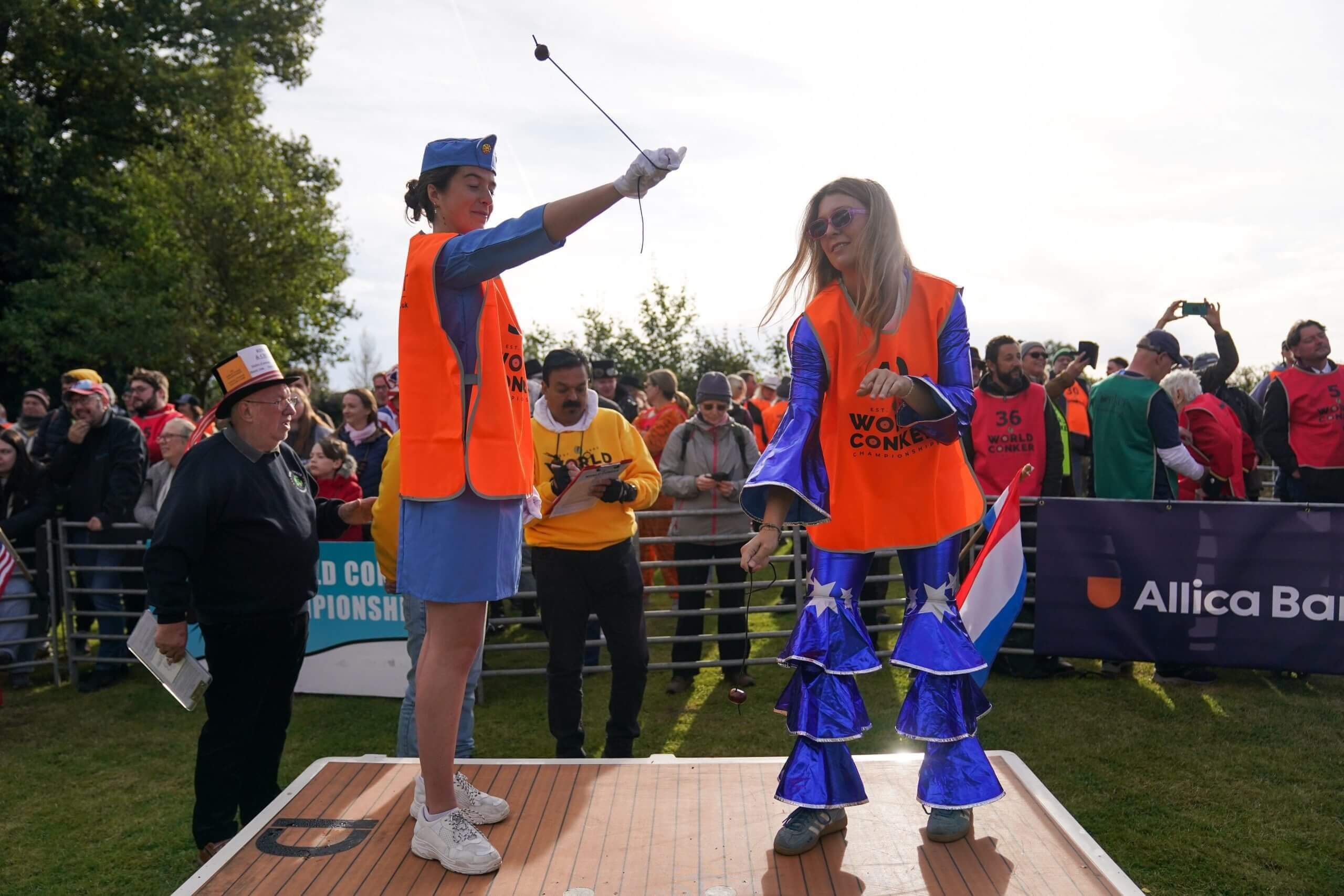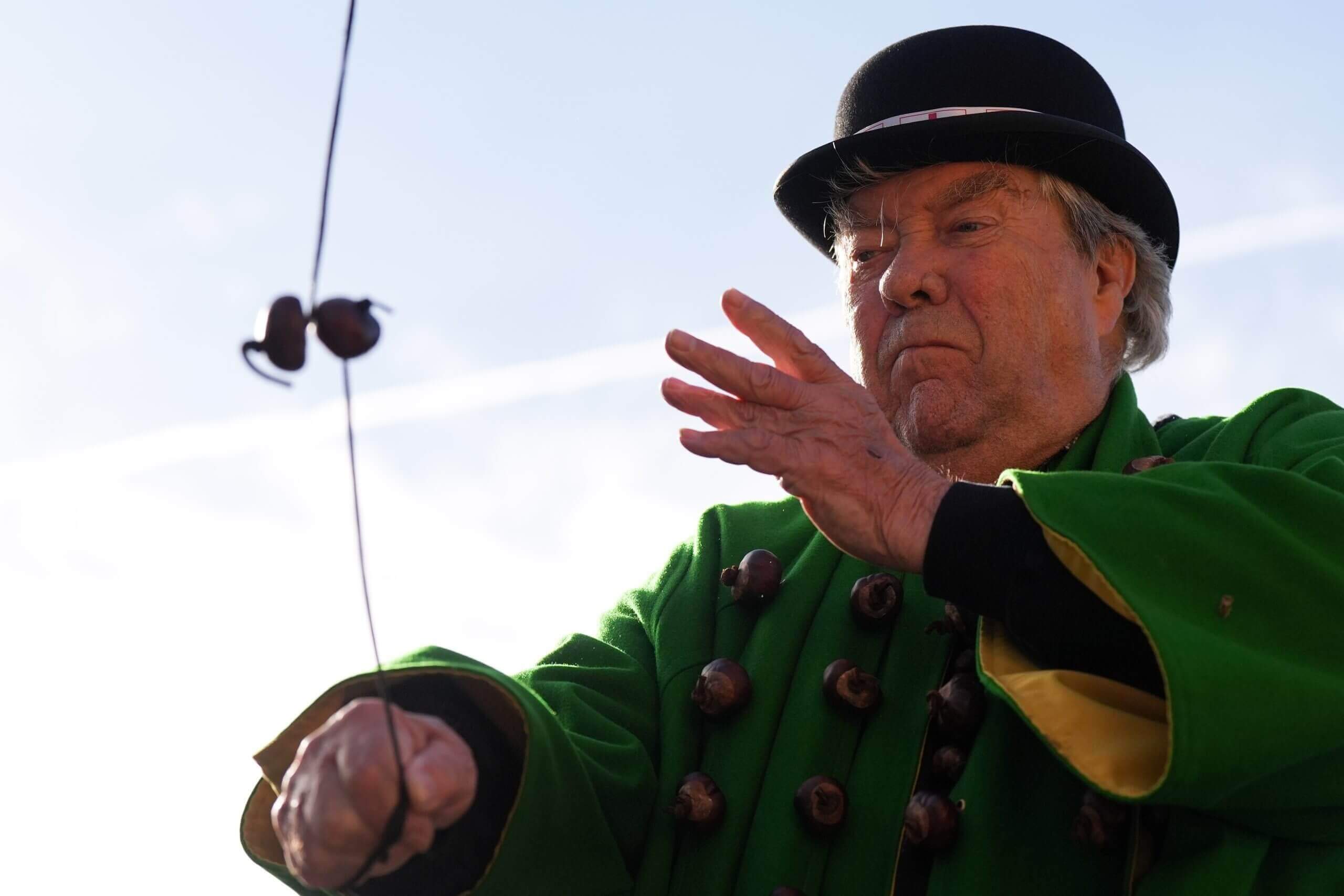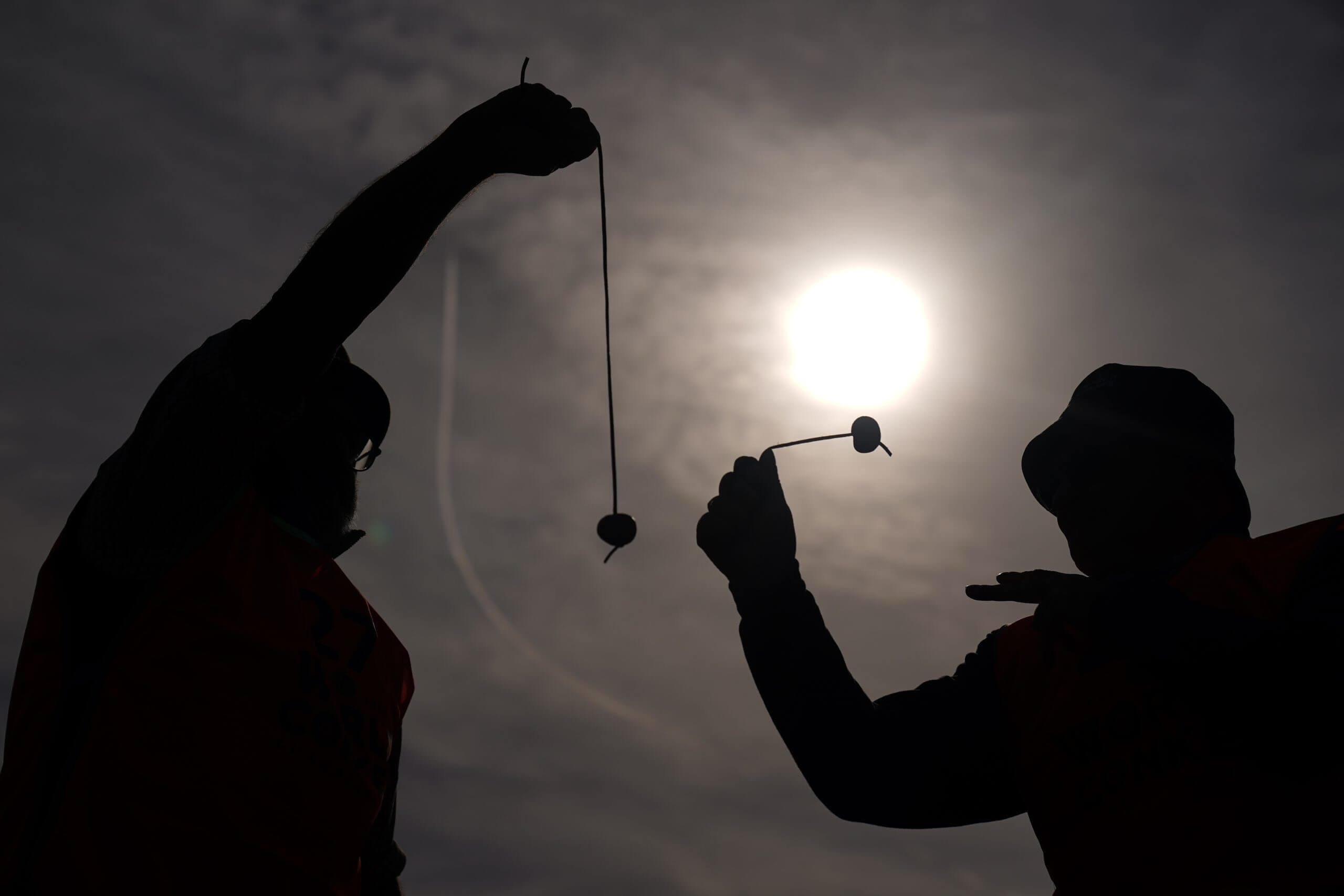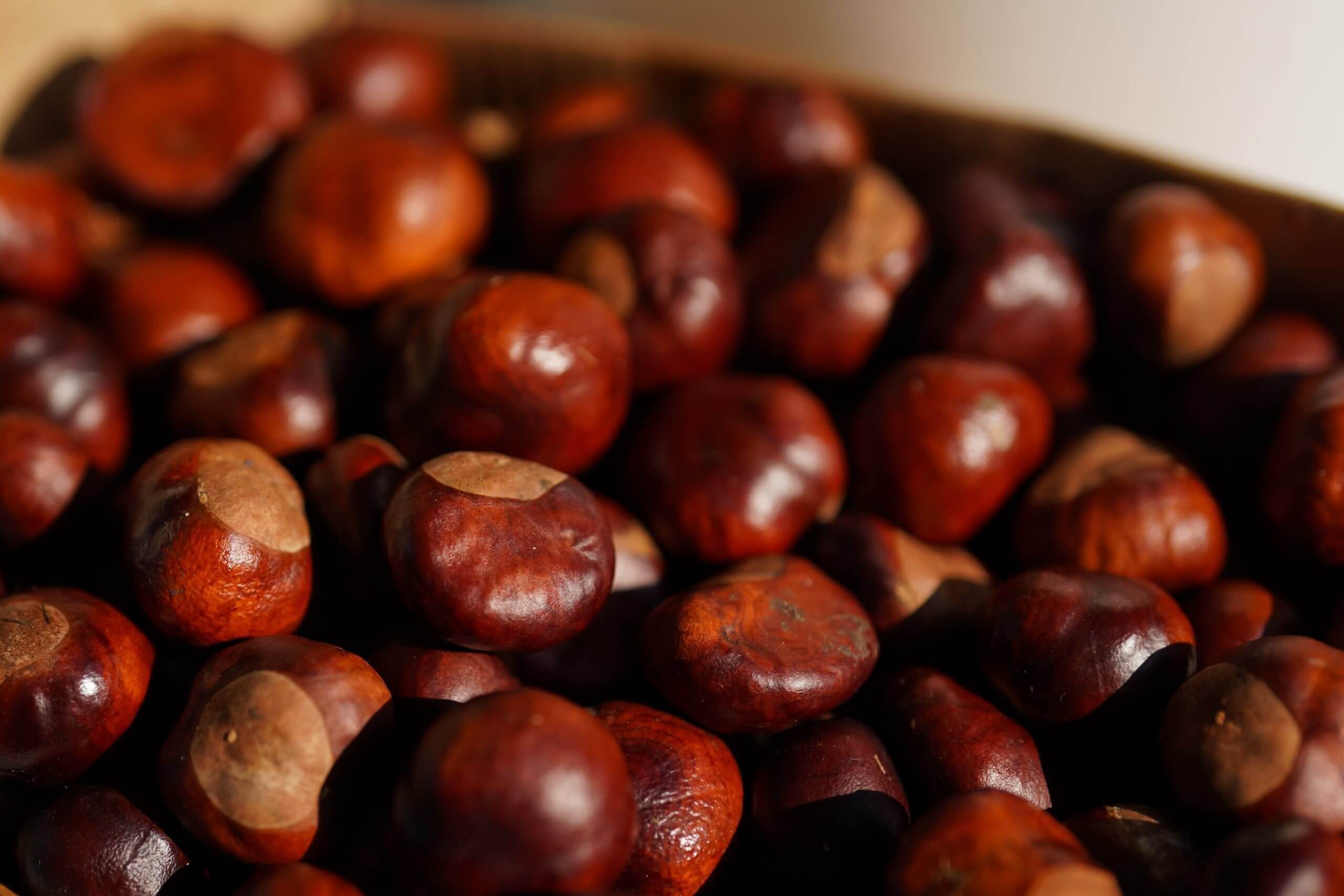
It could have come straight from the plot of a Shakespearean tragedy.
A king is challenged to a battle by a young pretender, with victory earned only by the destruction of the other. The king emerges triumphant, but there is suspicion that he has acted nefariously in the tussle for the crown.
Then a newcomer — a fair maiden from a foreign land — comes forth to vanquish the king. But that isn’t the end of the tale. It is only the beginning…
The story behind the controversy at this year’s World Conker Championships, which took place last weekend, has generated plenty of interest among the world’s media.
Conkers — a game where players take turns to smash a chestnut, or ‘conker’, suspended by a lace threaded through the centre using their own laced nut — has been played predominantly by children in Great Britain and Ireland since the early 1800s.

A match at this year’s World Conker Championships (Jacob King/PA Images via Getty Images)
It isn’t quite as quintessentially British as, say, bog snorkelling, cheese rolling or welly wanging. In fact, it is also played in parts of the United States using a buckeye nut — particularly in Ohio.
Ever since 1965, the world championships, which take place once a year, have been held in Northamptonshire in England and the current location is Southwick.
The last national census recorded the village’s population as 181 but every year, more than 250 adults and 100 children head there to battle it out in front of 2,000 spectators to be crowned conker champions and raise money for charity.
The event was started by a group of fishermen who, one day, found the weather to be unsuitable for their usual pastime so they played conkers instead and raised some money for one of their relatives who was blind. That tradition has carried on ever since, with £420,000 ($548,000) raised for charities associated with the blind and partially sighted.
It is usually a light-hearted event that has attracted contestants from all over the globe. In previous years, there has been an overall winner from Canada and this year, the children’s winners were from Germany and Latvia, the team winners were from the Netherlands and the overall winner and new Queen Conker of the event was Kelci Banschbach, a 34-year-old originally from Indianapolis, the first American to win the title. (The men’s winner faces the women’s winner in a grand final.)
Banschbach only arrived to work in the UK in 2022 and entered the competition to help immerse herself in the local culture, but emerged as a surprise winner at the competition this year.
However, the reason the 2024 edition has achieved such notoriety is because of the man she defeated in the overall final, David Jakins, an 82-year-old tournament veteran who also serves as a judge at the championships.

Jakins in action last weekend (Jacob King/PA Images via Getty Images)
This year was Jakins’ 46th attempt to win the men’s event and he finally achieved his dream by beating Alastair Johnson-Ferguson — a 23-year-old civil engineer from London who had travelled to experience the event with some Japanese friends — in the male final.
Jakins smashed Johnson-Ferguson’s conker with his first swing (contestants flip a coin to see who goes first), having won his semi-final in two hits. An impressive feat — especially as the harder you strike, the greater the risk of smashing your own conker.
Later, Jakins showed a fake, steel conker, painted and almost indistinguishable from a real conker, to a journalist who then informed organisers and this is where the drama ramped up a notch.
An investigation is being carried out with video footage being studied to see if anything untoward took place in the men’s final. Did the King Conker, after almost half a century of trying, cheat to secure his crown by using a steel conker so powerful and indestructible that he was guaranteed victory? Had the judges, who watched each bout intently to ensure the strict rules were adhered to, been hoodwinked?
“We are a very serious organisation and take conkers seriously,” says spokesman St John Burkett to The Athletic. “We want to carry out the investigation properly. I don’t think we have ever had anything like this before. So we have to make sure everything is clear and transparent.”
It isn’t unheard of for skullduggery to take place in conkers. Soaking your nut in vinegar, roasting it or even injecting resin into it are all believed to increase its solidity.

The game of conkers has been played for more than 200 years (Jacob King/PA Images via Getty Images)
“You could use a year-old conker, or my godfather, who was twice champion, used to say the best conker is one that has been passed through a pig,” Burkett says. “He used to tell a long story about how you get a conker into a pig’s mouth without the pig chewing it. Then you have to follow it around to find the conker when it comes out the other end.”
So, clearly, it is not unusual for people to go to extreme lengths to win a conker bout. But did King Conker dip into the dark arts too?
Rick Murphy, who has served as a judge at the competition alongside Jakins for 30 years, oversaw his semi-final win and was metres away from the action in the men’s final.
“It is very unlikely you could cheat at the world championships,” he tells The Athletic, explaining that around 3,500 conkers, which are ready for battle after September 30, are selected by the committee and prepared by volunteers, including Jakins, and then placed randomly in bags and taken to the different locations to be selected. This hugely decreases the chances of a rogue nut being prepared and selected by any perpetrator. The judges also watch intently for any sleight of hand going on.
“A steel conker would weigh about 10 times as much,” Murphy says. “So if a player started hitting with it, the dynamics of it would be so different to a normal conker that an experienced judge would spot it straight away. It would be swinging completely differently and much faster, or the player would have to lift that conker much more to get a swing on it because of the weight. Taking into account all those things, it is very unlikely you could cheat.”
Having known Jakins — who happily wanders around the event in his decorated robes posing for photographs — for three decades, Murphy is extremely sceptical that the 82-year-old, who denies all the allegations and says he uses the steel nut to amuse children by challenging them to the impossible task of smashing it, would tarnish the game’s image.
“I was in the ring for the men’s final, but I wasn’t one of the official judges,” he says. “I stood back a few feet to give spectators and the press a chance to see, rather than blocking their view and (as a result) my view was partially blocked.
“It all happened so quickly, literally the first swing and there were bits of conker flying. Now, that isn’t as rare as people may think. My own conker was broken in the first round by the first strike. It was like: ‘Gosh, what happened? Is it over already?’.”
But Murphy had no suspicions.
“I’ll tell you why,” he adds. “I was the umpire for the semi-final and it was a similar thing: two strikes. Again, I saw him draw the conker randomly. I saw how the conker moved. I didn’t see him put his hand into his pocket, so I was quite convinced that there was nothing odd going on.
“I know David quite well and, although he would be keen to fulfil his ambition to win the competition, I’m sure he wouldn’t cheat to do it.”

These conkers were all used at the championships (Jacob King/PA Images via Getty Images)
This is where the tale gets a little dark, as the attention since the event, which has included television and radio coverage and reports in the written media, has caused some upset — and not just to Jakins, who declined to comment when contacted by The Athletic.
Initial reports suggested that Johnson-Ferguson had complained to the organisers after the event, leading the chairman Jim Packer to brand him a “sore loser”. However, the men’s runner-up now seems to have calmed down a little.
“I hadn’t played since I was 10 and only went along for a laugh,” Johnson-Ferguson tells The Athletic. “It was completely fair and I had no problem with anything.
“I did see him (Jakins) put the conker in one pocket and pick out another. That happened, but he was probably just keeping his winning conker as a souvenir. It was a fun day and there was a great atmosphere. I enjoyed it but it has been tainted by what has happened since.”
“To be called a sore loser by the chairman wasn’t nice. I thought it was a lighthearted story, and it is in general, but no one likes to have their name dragged through the mud in the national news. If you had asked me the day after whether I would go back again, I would have said yes, but I am not sure now.”
The tale is not yet over. At the time of the publication of this article, the investigation was still ongoing. But for now, the king keeps his crown.
But regardless of what happens over the next few days, Jakins’ steel nut will live long in conker infamy.
(Top image: Artwork by Meech Robinson; Photos from Getty Images)